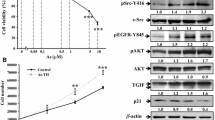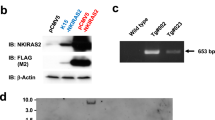Abstract
Tumor promoting effects of arsenic are believed to be associated with its transactivation activity on transcription factors, such as AP‐1 and NFκB. However, the results from different groups studying the effects of arsenic on NFκB activation are contradictory in different cell models. Since arsenic is a strong skin carcinogen, we have investigated the activation of NFκB by arsenic in a mouse skin epidermal cell line, JB6 cells. Exposure of cells to arsenite or arsenate led to NFκB transactivation in mouse epidermal JB6 NFκB‐luciferase reporter stable transfectants, C141 NFκB mass1. This induction of NFκB activity by arsenic was dose‐ and time‐dependent. The transactivation of NFκB by arsenic appeared to be through activation of Erks and JNKs pathways because increased NFκB activity by arsenic could be dramatically inhibited by either pre‐treatment of cells with PD98059 or overexpression of dominant negative JNK1. That Erks activation is required for arsenic‐induced NFκB transactivation was further supported by the findings that arsenic‐induced NFκB transactivation was impaired in JB6 30.7b cells, which were deficient in Erks.
Similar content being viewed by others
References
Knowles FC, Benson AA: The enzyme inhibitory form of inorganic arsenic. Z Gesamte Hyg 30: 625–626, 1984
Bettley FR, O'shea JA: The absorption of arsenic and its relation to carcinoma. Br J Dermatol 92: 563–568, 1975
Landolph JR: Molecular mechanisms of transformation of C3/H10T1/2 C1 8 mouse embryo cells and diploid human fibroblasts by carcinogenic metal compounds. Environ Health Perspect 102(suppl 3): 119–125, 1994
Evans S: Arsenic and cancer. Br J Dermatol 97(suppl 15): 13, 1977
Goyer RA: Toxic effects of metals. In: C.D. Klaassen, M.O. Amdur, J. Doull (eds). Toxicology. The Basic Science of Poisons. Macmillan Publishing Company, New York, 1986, pp 582–635
Chen C-J, Wang C-J: Ecological correlation between arsenic level in well water and age-adjusted mortality from malignant neoplasms. Cancer Res 50: 5470–5474, 1990
Chan PC, Huff J: Arsenic carcinogenesis in animals and in humans: Mechanistic, experimental, and epidemiological evidence. Environ Carcinogen Ecotoxicol Rev C15: 83–122, 1997
National Institute for Occupational Safety and Health: National Occupational Exposure Survey (1980-1983). Department of Health and Human Services, Cincinnati, OH, 1984
Lansdown ABG: Physiological and toxicological changes in the skin resulting from the action and interaction of metal ions. Crit Rev Toxicol 25: 397–462, 1995
Luchtrath H: The consequences of chronic arsenic poisoning among Moselle wine growers. Pathoanatomical investigations of post-mortem examinations performed between 1960 and 1977. J Cancer Res Clin Oncol 105: 173–182, 1983
Philipp R: Arsenic exposure: Health effects and the risk of cancer. Rev Environ Health 5: 27–57, 1985
Snow ET: Metal carcinogenesis: mechanistic implications. Pharmac Ther 53: 31–65, 1992
Huang C, Ma W-Y, Li J, Goranson A, Dong Z: Requirement of Erks, but not JNKs, for arsenite-induced cell transformation. J Biol Chem 274: 14595–14601, 1999
Cavigelli M, Li WW, Lin A, Su B, Yoshioka K, Karin M: The tumor promoter arsenite stimulates AP-1 activity by inhibiting a JNK phosphatase. EMBO J 15: 6269–6279, 1996
Ludwig S, Hoffmeyer A, Goebeler M, Kilian K, Häfner H, Neufeld B, Han J, Rapp UR: The stress inducer arsenite activates mitogen-activated protein kinases extracellular signal-regulated kinases 1 and 2 via a MAPK kinase 6/p38-dependent pathway. J Biol Chem 273: 1917–1922, 1998
Huang C, Ma WY, Li J, Dong Z: Arsenic induces apoptosis through a c-Jun NH2-terminal kinase-dependent, p53-independent pathway. Cancer Res 59: 3053–3058, 1999
Huang C, Ma W-Y, Bowden GT, Dong Z: Ultraviolet B-induced activated protein-1 activation does not require epidermal growth factor receptor but is blocked by a dominant negative PKCλ/ι. J Biol Chem 49: 31262–31268, 1996
Huang C, Chen N, Ma W-Y, Dong Z: Vanadium induces AP-1 and NFκB-dependent transcription activity. Int J Oncol 13: 711–715.
Huang C, Ma W-Y, Young MR, Colburn N, Dong Z: Shortage of mitogen-activated protein kinase is responsible for resistance to AP-1 transactivation and transformation in mouse JB6 cells. Proc Natl Acad Sci USA 95: 156–161, 1998
Dong Z, Birrer MJ, Watts RG, Matrisian LM, Colburn NH: Blocking tumor promoter induced AP-1 activity inhibits induced transformation in JB6 cells. Proc Natl Acad Sci USA 91: 609–613, 1994
Bernstein LR, Colburn NH: AP-1/jun function is differentially induced in promotion-sensitive and resistant JB6 cells. Science 244: 566–569, 1989
Watts RG, Huang C, Young MR, Li JJ, Dong Z, Pennie WD, Colburn NH: Expression of dominant negative Erk2 inhibits AP-1 transactivation and neoplastic transformation. Oncogene 17: 3493–3498, 1998
Huang C, Li J, Ma W-Y, Dong, Z: JNKs activation is required for JB6 cell transformation induced by TNF-α but not by TPA. J Biol Chem 274: 29672–29676, 1999
Huang, C, Li J, Ma W-Y, Chen N-Y, Dong Z: Activation of AP-1 by arsenate and arsenate in both cell and AP-1 luciferase-transgenic mice. FASEB J: 2000 (submitted)
Chen N, Ma W-Y, Huang C, Ding M, Dong Z: Activation of PKC is required for arsenate-induced signal transduction. J Environ Pathol Toxicol Oncol 19: 297–305, 2000
Baldwin A: The NF-κB and IκB proteins: New discoveries and insights. Annu Rev Immunol 14: 649–683, 1996
Ghosh S, May MJ, Kopp EB: NF-κB and Rel proteins: Evolutionarily conserved mediators of immune responses. Annu Rev Immunol 16: 225–260, 1998
Li JJ, Westergaard C, Ghosh P, Colburn NH: Inhibitors of both nuclear factor-κB and activator protein-1 activation block the neoplastic transformation response. Cancer Res 57: 3569–3576, 1997
Gilmore TD, Koedood M, Piffat KA, White DW: Rel/NF-κB/κB proteins and cancer. Oncogene 13: 1367–1378, 1996
Baeuerle PA, Baltimore D: NF-κB: Ten years after. Cell 87: 13–20, 1996
Verma IM, Stevenson JK, Schwarz EM, Van Antwerp D, Miyamoto S: Rel/NF-κB/IκB family: Intimate tales of association and dissociation. Genes Dev 9: 2723–2735, 1995
Galang CK, Garcia-Ramirez J, Solski PA, Westwick JK, Der CJ, Neznanov NN, Oshima RG, Hauser CA: Oncogenic Neu/ErbB-2 increases Ets, AP-1, and NF-κB-dependent gene expression, and inhibiting Ets activation blocks Neu-mediated cellular transformation. J Biol Chem 271: 7992–7998, 1996
Finco TS, Baldwin AS Jr: Kappa B site-dependent induction of gene expression by diverse inducers of nuclear factor κB requires Raf-1. J Biol Chem 268: 17676–17679, 1993
Bruder JT, Heidecker G, Rapp UR: Serum-, TPA-, and Ras-induced expression from Ap-1/Ets-driven promoters requires Raf-1 kinase. Genes Dev 6: 545–556, 1992
Finco TS, Westwick JK, Norris JL, Beg AA, Der CJ, Baldwin AS Jr: Oncogenic Ha-Ras-induced signaling activates NF-κB transcriptional activity, which is required for cellular transformation. J Biol Chem 272: 24113–24116, 1997
Simeonova PP, Luster MI: Mechanisms of arsenic carcinogenicity: genetic or epigenetic mechanisms? J Environ Pathol Toxicol Oncol 19: 281–286, 2000
Simeonova PP, Wang S, Toriuma W, Kommineni V, Matheson J, Unimye N, Kayama F, Harki D, Ding M, Vallyathan V, Luster MI: Arsenic mediates cell proliferation and gene expression in the bladder epithelium: Association with activating protein-1 transactivation. Cancer Res 60: 3445–3453, 2000
Author information
Authors and Affiliations
Corresponding author
Rights and permissions
About this article
Cite this article
Huang, C., Li, J., Ding, M. et al. Arsenic‐induced NFκβ transactivation through Erks‐ and JNKs‐dependent pathways in mouse epidermal JB6 cells. Mol Cell Biochem 222, 29–34 (2001). https://doi.org/10.1023/A:1017974131948
Issue Date:
DOI: https://doi.org/10.1023/A:1017974131948




